| 1 testone | |
|---|---|

| |
| Obverse of the coins of HRE Charles V | |
| General information | |
| Country | |
| Value |
1 testone; ¼ scudo |
| Years |
1474–1552 |
| Measurements and composition | |
| Mass |
9.5–11 g |
| Diameter |
26–30 mm |
| Composition |
|
| Appearance | |
| Shape |
round |
| Obverse |
see text |
| Reverse |
see text |
| v · d · e | |
The 1 testone coin was issued by the Duchy of Milan from around 1474, during the reign of Duke Galeazzo Maria Sforza (1444–1476), until about 1556, when Holy Roman Emperor Charles V (Italian: Carlo V; 1500–1558) was King of Italy. Such coins had a value equal to ¼ of a scudo. They typically weigh between 9 and 11 grams and usually measure between 26 and 30 millimeters in diameter.
History[]
Coin of Galeazzo Maria Sforza (1474-1476)[]
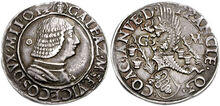
Testone of Galeazzo Maria Sforza
Galeazzo Maria Sforza reigned as the Duke of Milan from 1466 to 1476. He served as the duchy's fifth leader and was the second of the House of Sforza to hold such a position. Around 1474 he introduced the first testone of Milan, and all of Italy. It was engraved by Italian sculptor Cristoforo Foppa (1445–c. 1527), commonly known by the pseudonym Caradosso. Like many Milanese coins of the time period, it is non-dated. A right-facing depiction of Galeazzo Maria Sforza wearing a breastplate is featured in the center of the obverse, and behind his likeness is a small point in a circle. Both the portrait and the circle are enclosed within a circular boundary. At the top of the coin, outside the boundary, is a small bishop's head. Inscribed around the rim is a Latin legend that normally reads "GALEAZ • M • SF • VICECOS • DVX • MLI • QIT", although alternate lettering is common. It is an abbreviated form of Galeazzo Maria Sforza Vicecomitis Ducis Mediolani Quintus, which roughly translates to English as "Galeazzo Maria Sforza Visconti, Fifth Duke of Milan". The coat of arms of the House of Visconti in Milan – which consists of a Biscione, a heraldic charge showing a serpent in the process of devouring a human, in the center of an escutcheon – is featured at the bottom of the coin, slanted and surmounted by a large Biscione and two burning branches with two buckets hanging from them. The illustration of the Biscione separates the writing "G2 M" or "G3 M", which likely signifies "Galeazzo Maria". The legend around the rim, which often reads "PP • ANGLE • Q3 • CO • AC • IANVE • D •", is likely a shortened form of Papie Angleriae Que Comes ac Ianuae Dominus, which translates as "Count of Pavia and Angera and Lord of Genoa". Each of the three cities mentioned in the legend were at one point controlled by the House of Visconti, the rulers of Milan before the Sforzas.
Coins of Gian Galeazzo Sforza (1476-1494)[]
After the assassination of Galeazzo Maria Sforza in 1476, his son, Gian Galeazzo Sforza (1469–1494), was coronated as Duke of Milan at the age of nine in 1478. At first his mother, Bona of Savoy (1449–1503), served as his regent, but regency was later passed to his uncle, Ludovico Sforza "the Moor" (1452–1508), in 1481.

Coin of Gian Galeazzo featuring Bona of Savoy
The first testones issued during the reign of Gian Galeazzo Sforza were made during his mother's regency. In addition to the standard silver coins of the denomination, a gold pattern was also produced, which weighs between 17.3 and 20.66 grams and measures 28.5 to 29 millimeters in diameter. Like the coins of Galeazzo Maria Sforza, those of his son do not bear dates. A right-facing depiction of Bona is shown in the center of the obverse, enclosed within a circular border. The legend "BONA • 7 • IO • GZ • M • DVCES • MELI • VI", a possibly abbreviated form of Bona et Ioannes Galeazzo Maria Duces Mediolani Sextus, which roughly translates from Latin to English as "Bona and Gian Galeazzo Maria, Sixth Dukes of Milan". What is described as a phoenix, a mythological bird associated with the sun, is shown above flames in the center of the obverse. Separating it from the legend is a circular boundary. The words beyond the border make up the religious motto "SOLA • FACTA • SOLVM • DEVM • SEQVOR" (Sola facta, solum Deum sequor), which translates to "Being made solitary, I follow only God" or "Alone, I follow only God". Alternate versions of the legends on the obverse and reverse are known to exist.
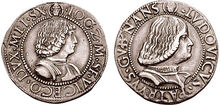
Testone of Gian Galeazzo with his and Ludovico's portraits
A new variety of testone was made under Gian Galeazzo Sforza during the regency of Ludovico "the Moor". A cuirassed portrait of a young Gian Galeazzo facing right is engraved in the center of the obverse, and is enclosed within a circular, beaded border. At the top of the coin, outside the border, is a bishop's head, which separates the beginning of the legend (to its right) from the end. This legend typically reads "IOGZ • M • SF • VICECO • DVX • MLI • SX", though similar variants are known to exist. It is an abbreviated form of Ioannes Galeazzo Maria Sforza Vicecomitis Ducis Mediolani Sextus, which translates to English as "Gian Galeazzo Maria Sforza Visconti, Sixth Duke of Milan". The reverse is very similar; it displays a right-facing image of Ludovico Sforza wearing a cuirass in the center, and like the portrait on the obverse, it is surrounded by a circular, dotted boundary. At the very top of the coin beyond the border is an image of a bishop's head, which, as on the obverse, separates the beginning of the legend from the end. The Latin legend "LVDOVICVS PATRVVS GVBNANS" (Ludovicus Patruus Gubnans), a shortened form of Ludovicus Patruus Gubernans, which translates roughly as "Ludovico, governing uncle", is inscribed around the rim.
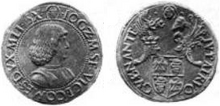
Testone of Gian Galeazzo with his portrait and the coat of arms of the House of Sforza
A third testone was issued during the reign of Gian Galeazzo Sforza, with Ludovico acting as his regent. Like the aforementioned second variety, it features a right-facing, cuirassed portrait of a young Gian Galeazzo in the center of the obverse, engraved within a circular, dotted border. The legend around the rim outside of the border reads "IOGZ • M • SF • VICECOMES • DVX • MLI • SX" (English: "Gian Galeazzo Maria Sforza, Sixth Duke of Milan"), and its beginning is separated from its end by a small bishop's head at the top of the coin. Unlike the other coin produced during the regency of Ludovico, it does not bear an image of the regent on the reverse, and featured instead is the arms of the House of Sforza – which consists of a crowned eagle in the first and fourth quarters of an escutcheon and a Biscione in the second and third. It is surmounted by a dragon-like Biscione on the left and a dragon with a bearded, human head on the right. At the top of the coin is a bishop's head identical to the one found on the obverse, but unlike on the obverse, a circular border does not separate the illustrations from the legend, which reads "LV • PATRVO • GVBNANTE" (Ludovicus Patruo Gubnante; English: "Ludovico, governing uncle"). The arms of the Sforza family typically interrupts the legend between the word "PATRVO" and "GVBNANTE".
Coins of Ludovico Sforza as duke (1494-1500)[]
After nearly thirteen years of serving as regent under Gian Galeazzo, in 1494 Ludovico Sforza became the seventh Duke of Milan after the former's mysterious death, which is believed to be the Ludovico's doing. At some point during his reign, he changed his surname from "Visconti" to "Anglus", as is shown on the coinage from his period as duke.

Testone of Ludovico as duke
Only one circulation testone is believed to have been issued during the dukedom of Ludovico Sforza. Such a coin features a right-facing, cuirassed likeness of the duke similar to that found on the earlier testones with portraits of Gian Galeazzo and Ludovico. Encircling the image is a circular, dotted border. Inscribed around the coin's rim, outside of the circular boundary, is the Latin legend "LVDOVICVS • M • SF • ANGLVS • DVX • MLI", a shortened form of Ludovicus Maria Sforza Anglus Ducis Mediolani, which translates to English as "Ludovicus Maria Sforza Anglus, Duke of Milan". The beginning of the legend is separated from the end by a bishop's head at the very top of the coin. Featured in the center of the reverse is the coat of arms of the House of Sforza, surmounted by a crown and flanked to both sides by a burning branch holding up two buckets. A palm branch is present to the left of the crown while an olive branch is shown to the right. Encircling the entire illustration is a single dotted border, and outside it, at the top of the coin, is a bishop's head. Inscribed around the coin's periphery is the Latin text "PP • ANGLE • Q3 • CO • AC • IANVE • D •" (English: "Count of Pavia and Angera and Lord of Genoa") or a variant of it, and after it is a "7C", which likely represents the name "Ludovico".

The 1497 pattern of Ludovico and the coat of arms of the House of Sforza
In 1497 a pattern testone composed of bronze was produced. Such a coin weighs between 6.6 and 7 grams and measures 26 millimeters in diameter. The signature right-facing bust of Ludovico Sforza is present in the middle of the obverse, but unlike all previous testones the illustration is not separated from the legend by a border. The standard bishop's head is featured at the very top of the coin. Around the coin's rim is the Latin legend "LVDOVIC • M • SF • ANGLV • DVX • M", a shortened form of the "LVDOVICVS • M • SF • ANGLVS • DVX • MLI" shown on Ludovico's silver circulation coins. This legend is typically interrupted between the "SF" and "ANGLV" by the bottom of the duke's likeness. Inscribed below the image is the date "1497" written upside-down. The coat of arms of the House of Sforza is featured at the top center of the reverse, and is surmounted by a crown flanked on the left by a palm branch and on the right by an olive branch. The letters "LV", representing "Ludovico", are shown in the middle of the coin, separated from each other by the depiction of the arms. Starting near the olive branch and extending to the other side of the reverse is the Latin legend "PP: ANG: Q3: CO: AC: ANVE: D", a shorter form of the standard "PP • ANGLE • Q3 • CO • AC • IANVE • D" found on the circulation testone of Ludovico. Francesco (1847–1919) and Ercole Gnecchi erroneously report a 1494 date in the supplement of Monete di Milano, when in actuality the piece they observed bore the year 1497.

The 1497 pattern featuring Ludovico and Beatrice d'Este
A second bronze pattern testone was made during the same year as the aforementioned piece. It was intended to commemorate Beatrice d'Este (1475–1497), the duchess of Milan and wife of Ludovico, who died at the age of twenty-one in 1497 during child birth. The dies used to produce the obverse of the coin were identical to those used for the aforementioned 1497 pattern, making the obverse identical with the same portrait of Ludovico, the same legend, and the same inverted year. A left-facing bust of Beatrice is engraved in the center of the reverse, enclosed within a circular, beaded border. At the very top of the coin, outside the border, is a Cross pattée, which separates the beginning of the legend from the end. This legend reads "BEATRIX: SF: ANGLA: ESTIS: DVCISA: MLI", a shortened form of Beatrix Sforza Anglus Estenses Ducissa Mediolani, which translates as "Beatrice Sforza Anglus d'Este, Duchess of Milan". Non-dated examples with the text "BEATRIX • SF • AN • EST • DVX • MLI • 7 • C" and "BEATRIX • SF • ANGL • ESTSIS • DVCISA • M" and an example with the date 1494 on the reverse are recorded, but the legends are believed to be misinterpretations of what is on the verified coins. Silver varieties are also known to exist, but their inaccurate weight suggests them to be modern forgeries.
Coins of Louis XII of France (1500-1513)[]
Louis XII (1462–1515), the King of France from 1498 to 1515, assumed his position as Duke of Milan after ousting Ludovico Sforza at the Battle of Novara fought between Milan and the Kingdom of France. Like Ludovico, his name in Latin was "Ludovicus". This name appeared on all of the coinage issued in Milan during his reign.
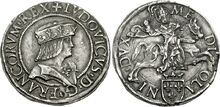
The testone of Louis XII with Saint Ambrose on horseback
One testone of Louis XII features a bust of the monarch facing towards the right in the center of the obverse. On his head is a cap decorated with several fleurs-de-lis (⚜), stylized lilies associated with the French, and on Louis' chest is another of the symbols. The entire likeness is enclosed within a circular boundary separating it from the legend written around the coin's rim. A cross potent (☩), or crutch cross, is engraved at the very top of the obverse beyond the circular border. The legend, which typically reads "LVDOVICVS • DG • FRANCOR(VM) • REX" or something similar, starts at the right of the cross and extends to its left. It is a shortened form of Ludovicus Dei Gratia, Francorum Rex, which translates from Latin as "Louis by the Grace of God, King of the Franks". Featured in the center of the reverse is a depiction of Saint Ambrose (c. 340–397), the patron saint of Milan, riding on a horse that is galloping to the right. He is wearing what is described as a paludamentum on his body and a mitre on his haloed head, and is shown holding a whip in his right hand. Below the illustration, at the very bottom of the coin, is the coat of arms of the Kingdom of France, which at the time consisted of a crowned escutcheon decorated with three fleur-de-lis. A circular border is present, but portions of the image of Saint Ambrose on horseback and the coat of arms below it break past it into the area of the legend. All known varieties of the coin use the Latin legend "MEDIOLANI DVX", which translates to "Duke" or "Duchy of Milan".

The testone of Louis XII with Saint Ambrose seated
A second variety of testone of Louis XII, misidentified as a ducatone in the Corpus Nummorum Italicorum, is known to exist. In addition to the standard silver coins, gold patterns weighing 6.9 grams are also known to exist. Featured in the center of the obverse is the coat of arms of France with a point in its center. Flanking the escutcheon on both sides is a fleur-de-lis, and above the crown are two crosses. A circular border surrounds much of the arms, but the tip of the escutcheon and the uppermost portions of the crown typically expand past it without interrupting the legend inscribed around the rim. This legend reads either "LVDOVIC' DG FRANCOR REX", "LUDVOVIC' DG REX FRANCOR", or "LUDOVICUS REX FRANCOR". The first two are abbreviated versions of Ludovicus Dei Gratia, Francorum Rex or Ludovicus Dei Gratia, Rex Francorum (English: "Louis by the Grace of God, King of the Franks"), while the last is simply an abbreviation for Ludovicus Rex Francorum, which has the same meaning as the aforementioned legends, but lacks "by the Grace of God". A seated image of Saint Ambrose is shown on the reverse. On his body is a paludamentum with a rose, and on his haloed head is a mitre. In his right hand (at the left) he holds a whip, and with his left he is holding up a crosier. The entire illustration extends beyond the small circular border engraved around it, spanning from the very top of the coin to the bottom. Inscribed around the rim is the legend "MEDIOLANI DVX" (English: "Duke of Milan" or "Duchy of Milan"), which is typically interrupted by the image of Saint Ambrose between the "L" and "A" or "A" and "N" in "MEDIOLANI". A fleur-de-lis is usually shown near the end of the legend.
Coin of Francis I of France (1515-1521)[]
Louis XII was succeeded as Duke of Milan by Maximilian Sforza (1493–1530), the eldest son of Ludovicio Sforza, in 1513. However, after the French victory in the Battle of Marignano in 1515, Maximilian was sent into exile and French rule of Milan was briefly restored by King Francis I (1494–1547), Louis' cousin.
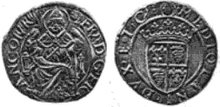
Testone of Francis I
Only one main variety of circulated testone is known to have been made during Francis' reign, and a 6.72 gram copper pattern with the same designs also exists. Featured on the obverse is what appears to be the same image of Saint Ambrose shown on one of the testones of Louis XII. However, the legend inscribed around the rim reads "FR DG FRANCOR R" instead of "MEDIOLANI DVX", and is almost always separated between the "R" and "A" in the word "FRANCOR". Also, the fleur-de-lis at the end of the legend is absent. The legend is an abbreviated form of Franciscus Dei Gratia, Francorum Rex, which translates from Latin as "Francis by the Grace of God, King of the Franks". A crowned, quartered escutcheon is featured in the center of the reverse, with the first and fourth quarters containing three fleur-de-lis and the second and third quarters featuring the Biscione, respectively representing France and Milan. The image is enclosed within a circular border. This border is typically overlapped by the bottom of the escutcheon and some of the tips on the crown, but only a small portion of the arms usually extends past it. The bishop's head from many earlier Milanese testones is shown at the very top of the reverse outside the border. Starting to the right of the head and ending towards its left is the legend "MEDIOLANI DVX ET C", which translates to English as "Duke of Milan, et cetera".
Coin of Francesco II Sforza (1521-1535)[]
Francesco II Sforza (1495–1535), the second son of Ludovico Sforza, became the Duke of Milan after the state was reconquered by Holy Roman Emperor Charles V in 1521. There was a brief period from late 1524 to early 1525 when Francis I regained control of the duchy, but power was soon after restored to Francesco II, who would continue to reign for ten more years before his death in 1535.

Testone of Francesco II Sforza
Only one main type of testone was produced during the reign of Francesco II Sforza. An identical or similar image of Saint Ambrose shown on the testones of Louis XII and Francis I is featured on the obverse, extending beyond the standard circular boundary. Inscribed around the rim is the legend "S(A) AMBROSIVS", which is interrupted by the image of Milan's patron saint between the "B" and "R" or "R" and "O" in "AMBROSIVS". The legend is a shortened form of Sanctus Ambrosius, meaning "Saint Ambrose" in English. Depicted on the reverse is the coat of arms of the House of Sforza surmounted by a large crown. To the left of the crown is a palm branch, and to the right of it is an olive branch. Much of the image is enclosed within a circular border, although portions overlap and even extend past the boundary. A bishop's head is featured at the very top of the coin above the crown. "FRANC SF VICECO DVX MLI", a shortened form of Franciscus Sforza Vicecomitis, Ducis Mediolani which translates as "Francesco Sforza Visconti, Duke of Milan", is inscribed around the coin's periphery, beginning to the right of the bishop's head and ending towards its left.
Coins of Charles V, Holy Roman Emperor (1535-1556)[]
Charles V (Italian: Carlo V) was a member of the House of Habsburg who held many titles during the 16th century, including Holy Roman Emperor (1530–1556) and King of Spain (1516–1556). He appointed his son, Philip II (1527–1598), to serve as Duke of Milan in 1540 after Francesco II Sforza died without an heir. Philip held this position until his death in 1598. The coins from the time period of 1535 to 1556 are often attributed to Charles due to the presence of his name and sometimes his likeness on the obverses. Six major types of testone were issued during this 21 year interval.

Dated testone of Charles V with the Pillars of Hercules
The first type, known as the testone con la colonne, imitates the Spanish coinage of the time period. An image of a laureate, bearded Charles V is shown facing right on the obverse. Encircling the likeness is the Latin text "IMP • CAES • CAROLVS • V • AVG", an abbreviation of Imperatore Caesar Carolus V Augustus, which translates to "Emperor and Caesar, Charles V Augustus". This legend starts just underneath the bust of Charles at the bottom of the coin and circles around the coin before ending near the bust truncation. The Pillars of Hercules, a symbol common on Spanish coins, consisting of two columns holding up a ribbon with the Latin motto Plvs Vltra (English: "further beyond"), is shown standing in a wavy sea on the reverse. There is no inscription present on this side of the coin, but the date "1552" is sometimes present at the top center between the pillars.

The testone con la Pietà
The next type, the testone con la Pietà, was commissioned for production by the Milanese senate to pay homage to Charles V. Displayed on the obverse is the same laureate, bearded, right-facing depiction of the emperor as shown on the testone con la colonne, along with the text "IMP • CAES • CAROLVS • V • AVG". However, unlike the aforementioned type, the head is much larger, making the legend start at the left of the likeness and end at the right, and usually be separated between "CAES" and "CAROLVS". An image similar to that found on the sestertius of Roman Emperor Caligula, consisting of a left-facing woman seated on a throne between Roman armor and holding a patera, is shown in the center of the reverse. Arched around the periphery above the depiction is the Latin text "• S • P • Q • MEDIOL • OPTIMO • PRINCIPI", a shortened form of Senatus Populus Que Mediolanum Optimo Principi, which translates to English as "(dedicated) to the good and excellent Prince by the senate and people of Milan". The word "PIETAS", representing one of the chief duties of Ancient Romans, is engraved below the illustration, at the bottom of the coin.

Testone with Saint Ambrose on horseback
The third type of testone is known as the testone con Santo Ambrogio a cavallo. Depicted on the obverse is the coat of arms of Spain – which at the time consisted of an escutcheon combining the arms of the places ruled by Charles V on the breast of a crowned, double-headed eagle. This image is shown at the bottom center, breaking through portions of the circular boundary that surrounds much of it. Starting at the upper right of the coin and ending at the top left is the legend "CAROLVS • RO • IMPERATOR", an abbreviation of Carolus Romanorum Imperator, which translates to English as "Charles, Roman Emperor". Featured on the reverse is an image of Saint Ambrose riding a horse that is galloping to the right. He is wearing a paludamentum on his body and a mitre on his haloed head, and in his hand is a whip. The legend "SANTVS AMBROSIVS" (English: "Saint Ambrose") is inscribed around the coin's rim, often interrupted by the illustration.
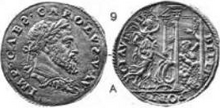
The testone con Pace
The fourth type is known as the testone con Pace. The same image of Charles V used on all of the testones featuring his likeness is shown on the obverse, accompanied by the same inscription, "IMP CAES CAROLVS V AVG", albeit with the letter "S" being written backwards in each case as "Ƨ". A symbol of peace is shown standing in front of a house where a chained woman is lying on the ground. The legend "CLAV D BELLI PORTE", a shortened form of Clau de Belli Porte which translates from Latin as "Closed the gates of war", is inscribed around the coin's rim, starting at the left side of the reverse and ending at the bottom.

The testone con la Salute
The fifth type is known as the testone con la Salute, and also as a denaro de 25 soldi. The same laureate, bearded, right-facing bust of Charles V from many of the testones from his reign is featured on the obverse, accompanied by the legend "IMP CAES CAROLVS V AVG". This legend starts at the bottom left of the coin and arches around the upper periphery of the coin before ending at the lower right. An image of Salus, the Roman goddess of security and well-being, is shown at the right center of the reverse, holding a staff in her left hand and a patera, which feeds a serpent rising from an altar, in her right. Next to this depiction is an image of a river deity lying, propped against an overturned urn that is spilling water. This image represents the Po, an important river in Italy, with the urn and deity symbolizing its source. Inscribed around the coin's upper rim is the Latin text "SALVS AVGVSTA" or "SALVTI AVG", a title for the deity Salus. At the very bottom of the coin is the inscription "PADVS MDL", "PADVS MLD", "PADAS M", "PADVS MDI", "PADVS MD", "PADVS MDL", "PADVS MLI", or "PADVS MID", with the Padus being the Latin name for the Po and the other portion of the text being an abbreviation for Mediolanum, Latin for "Milan". On many pieces the letter "A" is substituted by a character similar in appearance to a Greek lambda (Λ).
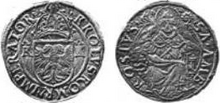
The testone with seated Saint Ambrose
The final of the six types of testones issued from 1535 to 1556 is known as the testone con Santo Ambrogio seduto. Featured in the center of the obverse is an escutcheon containing a double-headed eagle. Surmounting it is the Imperial Crown of Austria, which extends to the very top of the coin, past the circular boundary enclosing much of the arms. The shield divides the letters "KK", which are sometimes shown with the Greek letter omega (Ω) inscribed above them. Printed around the rim outside the circular border is the Latin text "KROLVS ROMR IMPERATOR", a shortened form of Karolus Romanorum Imperator, which translates to English as "Charles, Roman Emperor". The image of Saint Ambrose featured on the testones of Louis XII, Francis I, and Francesco II Sforza is present on the reverse, with portions of a circular border inscribed around its sides. The legend around the rim reads "SA AMBROSIVS" (English: "Saint Ambrose"), and is typically interrupted between the "B" and "R" in "AMBROSIVS".
References[]
- Levinson, Robert (January 2007). The Early Dated Coins of Europe: 1234-1500. Coin & Currency Institute. ISBN 0871846004
- Victor Emmanuel III (1927). Corpus Nummorum Italicorum. vol. 5.
Template:Coins of Milan
